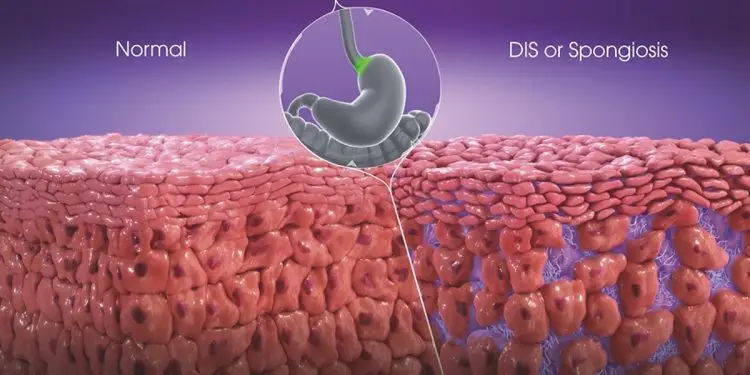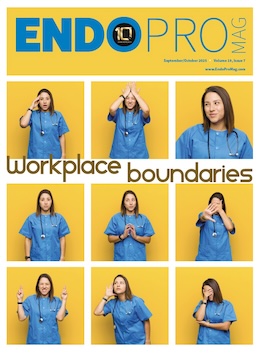Mucosal Integrity Contour Pattern: Proprietary ZVU® software generates a mucosal integrity contour pattern, visually representing the captured impedance values (see Fig. 3). This pattern provides clinicians with immediate insight into the integrity of the esophageal mucosa, with easy visualization of areas of reduced integrity (see Fig. 3). The contour pattern helps to distinguish between GERD, non-GERD, and EoE, and possibly provides targeted areas for biopsy or follow response to treatment over time.
Clinical Applications and Benefits
- Information at the time of endoscopy: Immediate information during an endoscopy is limited to what the endoscopist can appreciate visually. They may then miss subtle changes to the esophageal epithelium which do not present as esophagitis. Mucosal integrity testing provides an important additional real-time assessment, detecting early signs of mucosal compromise that other methods overlook. Adding the MI assessment to the physician’s current knowledge of the patient history, symptoms and medication may reduce diagnostic and treatment latency.
“MiVu is an important tool that finally allows us to comprehensively assess for reflux and enables the very early detection of reflux-related effects in the esophagus.” —Amir Masoud, MD. Gastroenterologist, Hartford, Connecticut. 1 - Differentiating Between GERD and EoE: GERD and EoE are common esophageal disorders that may present with similar symptoms but that require different Mucosal integrity testing helps differentiate these conditions by providing esophageal impedance values over at least 10 cm of the esophagus. EoE, a pan-esophageal condition, often presents longitudinal areas of reduced integrity, while GERD may show more distal areas (closer to the squamocolumnar junction, SCJ) of reduced integrity which improve proximally. Differentiating between these two conditions can help in determining the appropriate treatment strategy.
“There is a lot of symptom overlap between GERD and EoE. Current diagnostic tests for esophageal disorders, which are often inconclusive, make it challenging to provide patients with reliable, timely information that adequately guides the next steps. MiVu’s direct measurement provides accurate, instant data that can immediately direct therapy while helping to reduce the need for unnecessary testing.” —Dr. Michael Vaezi, Professor of Medicine and Otolaryngology at the Vanderbilt University Medical Center in the Division of Gastroenterology, Hepatology and Nutrition. 2 - Reducing the Need for Prolonged Monitoring and Biopsies: Mucosal integrity testing may reduce the need for prolonged pH monitoring or repeat biopsies by providing real-time data during endoscopy, improving patient comfort, reducing reliance on patient compliance, and streamlining the diagnostic process, allowing for faster decision-making. In those patients with non-erosive disease who had abnormal reflux by wireless pH monitoring, MI values were similar to those with erosive esophagitis. MI was superior in predicting erosive reflux compared to wireless pH monitoring, with a specificity of 95% and positive predictive value of 96% compared to 64% and 40%, respectively 3. MIT accurately predicted EoE during endoscopy with a sensitivity of 100% and a specificity of 96% without the need for 3
- Long-Term Treatment Management: Mucosal integrity testing has the potential to be valuable for evaluating the efficacy of prescribed In a clinical trial published in the journal Gastroenterology, Fehmi Ates and associates tested the device to assess MI. Subjects with LA Grade C and D esophagitis underwent MIT at both the initial endoscopy and 8 weeks post-PPI treatment. MI values increased and changed from a GERD impedance pattern to a non-GERD impedance pattern.3 By tracking changes in mucosal integrity over time, clinicians may be able to adjust treatment plans to ensure optimal outcomes.
- Future Directions and Broader Applications: Currently, MiVu from Diversatek Healthcare is the only FDA-cleared mucosal integrity system for sale in the It represents a significant breakthrough in gastroenterology that stands to transform the diagnosis and management of GERD, non-GERD and EoE. As this technology becomes more widely adopted, its applications may extend beyond GERD and EoE to other gastrointestinal disorders. While mucosal integrity testing currently focuses on the esophagus, this technology has the potential to be adapted for use in other parts of the gastrointestinal tract, such as the small bowel and colon, providing valuable insights into conditions like celiac disease and inflammatory bowel disease.
Conclusion








